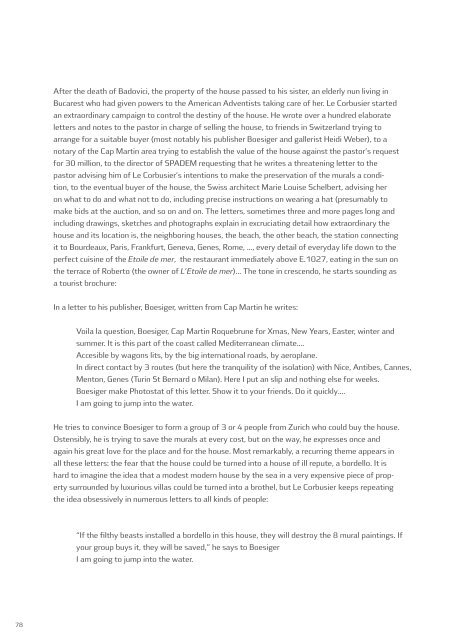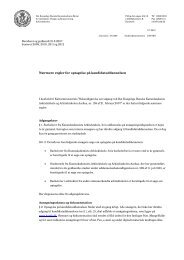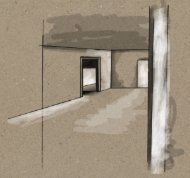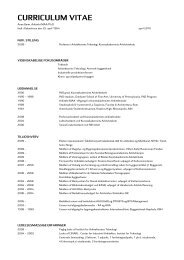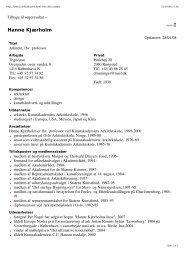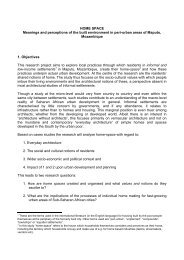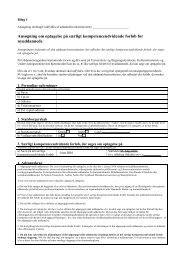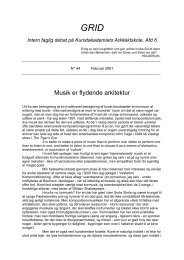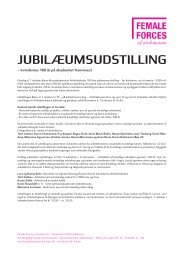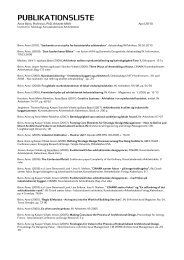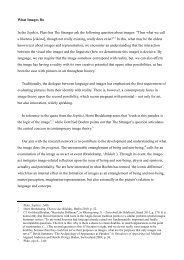of architecture - Kunstakademiets Arkitektskole
of architecture - Kunstakademiets Arkitektskole
of architecture - Kunstakademiets Arkitektskole
Create successful ePaper yourself
Turn your PDF publications into a flip-book with our unique Google optimized e-Paper software.
After the death <strong>of</strong> Badovici, the property <strong>of</strong> the house passed to his sister, an elderly nun living in<br />
Bucarest who had given powers to the American Adventists taking care <strong>of</strong> her. Le Corbusier started<br />
an extraordinary campaign to control the destiny <strong>of</strong> the house. He wrote over a hundred elaborate<br />
letters and notes to the pastor in charge <strong>of</strong> selling the house, to friends in Switzerland trying to<br />
arrange for a suitable buyer (most notably his publisher Boesiger and gallerist Heidi Weber), to a<br />
notary <strong>of</strong> the Cap Martin area trying to establish the value <strong>of</strong> the house against the pastor’s request<br />
for 30 million, to the director <strong>of</strong> SPADEM requesting that he writes a threatening letter to the<br />
pastor advising him <strong>of</strong> Le Corbusier’s intentions to make the preservation <strong>of</strong> the murals a condition,<br />
to the eventual buyer <strong>of</strong> the house, the Swiss architect Marie Louise Schelbert, advising her<br />
on what to do and what not to do, including precise instructions on wearing a hat (presumably to<br />
make bids at the auction, and so on and on. The letters, sometimes three and more pages long and<br />
including drawings, sketches and photographs explain in excruciating detail how extraordinary the<br />
house and its location is, the neighboring houses, the beach, the other beach, the station connecting<br />
it to Bourdeaux, Paris, Frankfurt, Geneva, Genes, Rome, …, every detail <strong>of</strong> everyday life down to the<br />
perfect cuisine <strong>of</strong> the Etoile de mer, the restaurant immediately above E.1027, eating in the sun on<br />
the terrace <strong>of</strong> Roberto (the owner <strong>of</strong> L’Etoile de mer)... The tone in crescendo, he starts sounding as<br />
a tourist brochure:<br />
In a letter to his publisher, Boesiger, written from Cap Martin he writes:<br />
Voila la question, Boesiger, Cap Martin Roquebrune for Xmas, New Years, Easter, winter and<br />
summer. It is this part <strong>of</strong> the coast called Mediterranean climate….<br />
Accesible by wagons lits, by the big international roads, by aeroplane.<br />
In direct contact by 3 routes (but here the tranquility <strong>of</strong> the isolation) with Nice, Antibes, Cannes,<br />
Menton, Genes (Turin St Bernard o Milan). Here I put an slip and nothing else for weeks.<br />
Boesiger make Photostat <strong>of</strong> this letter. Show it to your friends. Do it quickly….<br />
I am going to jump into the water.<br />
He tries to convince Boesiger to form a group <strong>of</strong> 3 or 4 people from Zurich who could buy the house.<br />
Ostensibly, he is trying to save the murals at every cost, but on the way, he expresses once and<br />
again his great love for the place and for the house. Most remarkably, a recurring theme appears in<br />
all these letters: the fear that the house could be turned into a house <strong>of</strong> ill repute, a bordello. It is<br />
hard to imagine the idea that a modest modern house by the sea in a very expensive piece <strong>of</strong> property<br />
surrounded by luxurious villas could be turned into a brothel, but Le Corbusier keeps repeating<br />
the idea obsessively in numerous letters to all kinds <strong>of</strong> people:<br />
“If the filthy beasts installed a bordello in this house, they will destroy the 8 mural paintings. If<br />
your group buys it, they will be saved,” he says to Boesiger<br />
I am going to jump into the water.<br />
To the pastor and the notary, he claims in different letters to be trying to preserve the house and<br />
the garden and avoid that it falls in the hands <strong>of</strong> “gens equivoques” insisting that, by contrast, the<br />
people he is trying to organize to buy the house represent “the most impeccable quality, honesty,<br />
understanding <strong>of</strong> the problem, desire to preserve this pied-de-terre modest but coquet, for spending<br />
the weekend or holidays <strong>of</strong> every kind”.<br />
To Mr. Duchemin, Secretary General <strong>of</strong> SPADEM he writes:<br />
What is the double threat? The brothel, precisely, the very scene <strong>of</strong> sexuality and femininity that<br />
he had tried to conquer through endless drawing. His fear is that the brothel will come to life as if<br />
projected back out from the images on the wall. The murals have to be protected both from destruc-<br />
78 79<br />
Fig. 14<br />
“The threat is double: On the one hand, the house could be bought by people who could make<br />
it a place <strong>of</strong> “rendez-vous,” perhaps picturesque! (the situation <strong>of</strong> the property and the house<br />
itself lend themselves to it), or it could be bought by people <strong>of</strong> taste – that we don’t know –<br />
and that will perhaps have as first attitude to cover the mural paintings in the walls”.


